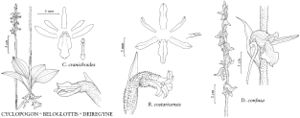Cyclopogon cranichoides
Beih. Bot. Centralbl. 37: 387. 1920.
Herbs small, to 40 cm. Roots fusiform, to 4.5 cm × 4–8 mm, fleshy. Stems subterranean, short. Leaves 3–8; petiole spreading to suberect, 1.1–3.5 (–5.5) cm; blade abaxially purplish, adaxially dark purplish green, sometimes with whitish markings, broadly elliptic to ovate, 2.5–8 × 1.3–3.8 cm, apex obtuse to acute. Inflorescences mottled, purplish; scape pubescent; raceme continuously elongating as fruits mature, to 15 cm, pubescent; floral bracts mottled, lanceolate, longer than ovary. Flowers tubular-funnelform; sepals greenish brown, pubescent; dorsal sepal midvein and margins dark near apex, narrowly elliptic to narrowly pandurate, 3.5–5 × 1.2–2 mm, apex acute; lateral sepals often reflexed, narrowly elliptic to narrowly pandurate, 4–6 × 1–1.5 mm, apex acute; petals greenish-brownish proximally, greenish white distally with midvein and apical margins dark-brown, narrowly spatulate-oblanceolate, 4.5 × 0.5–1 mm, apex acute, oblique; lip white, canaliculate, oblong, constricted distal to middle, broadest proximal to constriction, to 5 × 2.5 mm, base gibbose, with pair of tubercles, margins entire, apex slightly flared; column slender, 3.5 mm; pollinia yellow; pedicellate ovary 4–7 mm. Capsules erect, ellipsoid, 6–8 × 3.5–4.5 mm.
Phenology: Flowering Feb–Mar.
Habitat: In humus of shady moist hammocks
Elevation: 0–100 m
Distribution

Fla., West Indies, Central America, n South America
Discussion
Fruit production in Cyclopogon cranichoides is pollen limited (R. N. Calvo 1990). Natural fruit set was 26–62% over a 4-year period, whereas hand pollinations gave better than 96% fruit set. Contrary to most other studies of orchids, Calvo did not detect a cost of reproduction associated with resource constraints.
Selected References
None.
Lower Taxa
"broadest" is not a number."elongating" is not a number.
